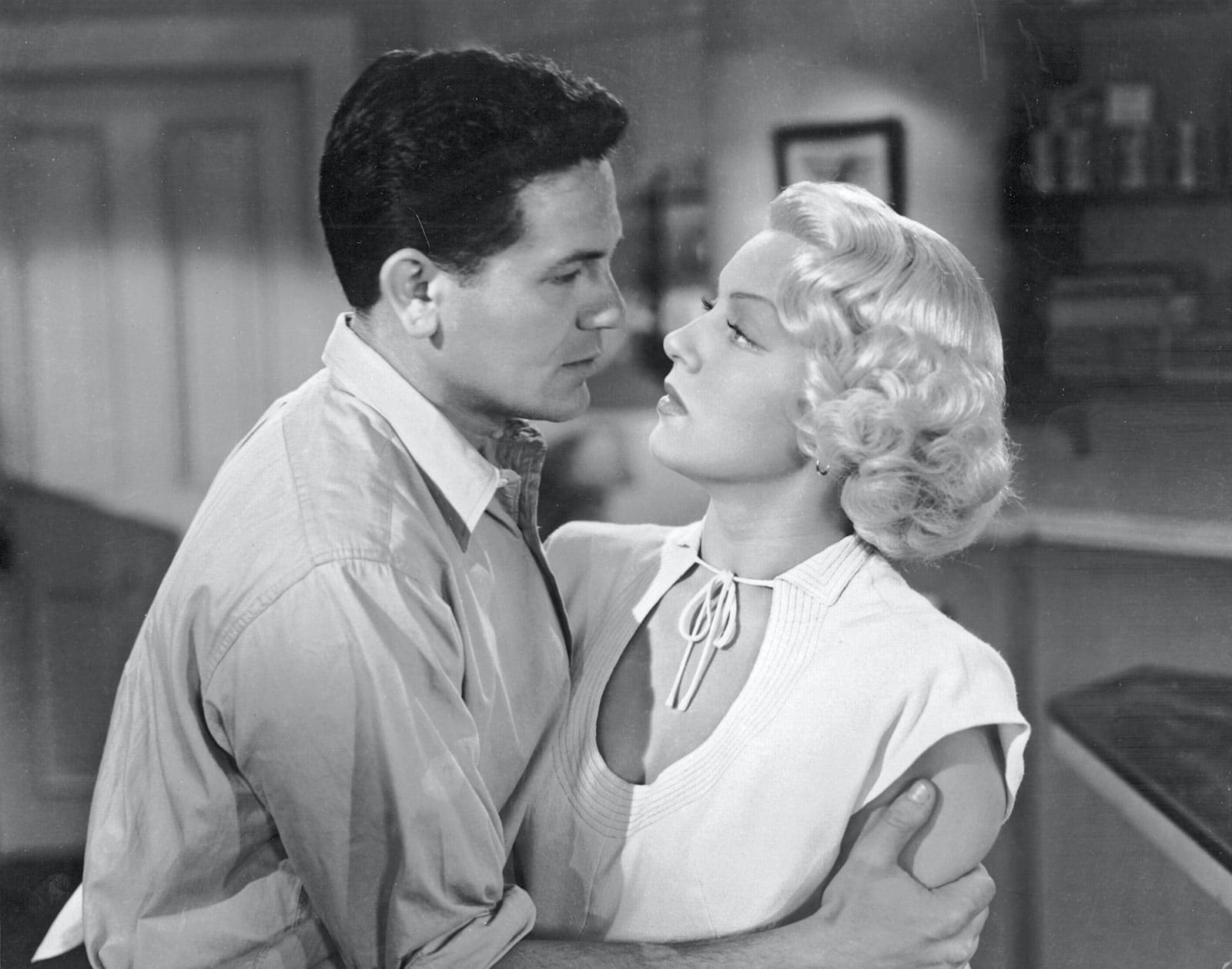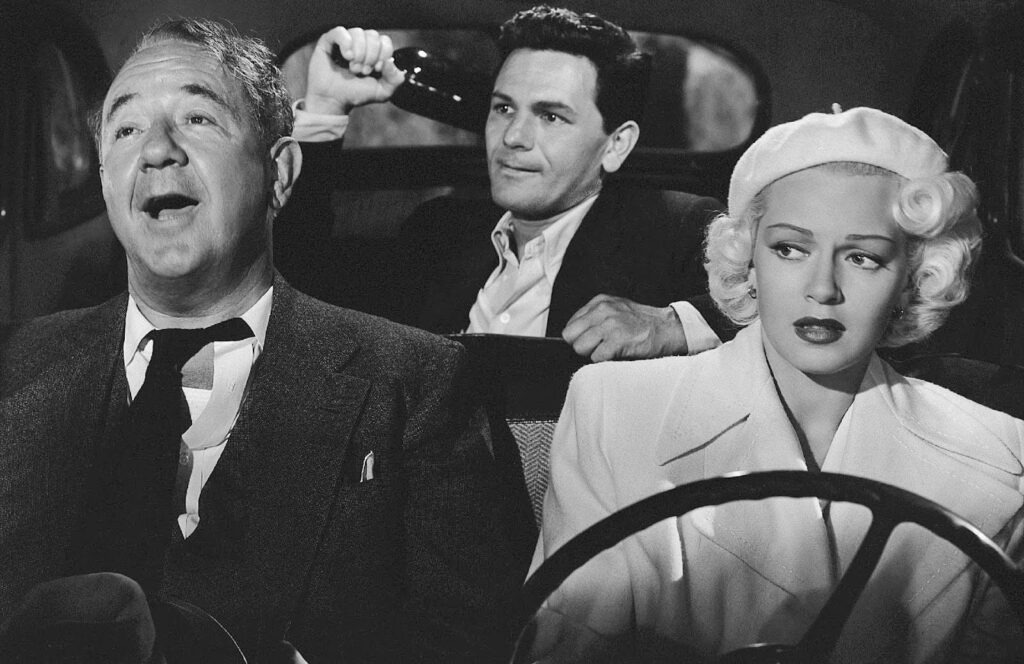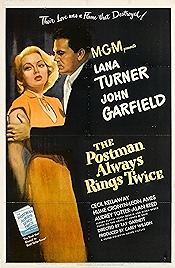Talking of twice, there are two good reasons why reviews of the movie The Postman Always Rings Twice almost invariably mention the book’s author, James M Cain. Cain’s name has no real resonance today, but in 1934 his book was a Fifty Shades of Grey shade of famous and had made a celebrity of the author. As a grown-up, sentient member of the public you had to take a position on the book – you’d read it, you’d read a review of it, or you’d taken ostentatiously decided not to read it. Love it or loathe it, you couldn’t ignore it.
The second was the opening credits to this 1946 screen version, which go very large on the name of Cain. To doom-laden, brassy intro music and after a “Metro-Goldwyn-Mayer presents” up in big letters comes “Lana Turner, John Garfield”, then the main title “In… The Postman Always Rings Twice a Novel by James M Cain” – the “In…” floating above a dramatically lit image of the book itself. This remains on screen while all the other credits scroll by, and is still there even when the “based on the novel by James M Cain” credit appears, thus giving Cain two on-screen credits simultaneously.
So, a sensation that’s really being sold hard. Hollywood was late to the Cain party. For good reason. His book had been published at precisely the moment when Hollywood was cleaning up its act. In the mid-1930s The Postman Always Rings Twice’s steamy, sex-and-murder storyline was exactly the sort of thing the studios were backing away from. Some years down the line the studios relearned how to tackle dark and difficult topics, using suggestion where early 1930s movies had been overt. By that point, of course, out in the wider world a war was raging, women were doing “men’s work” in munitions factories and the way they were represented on screen was changing too.
But the thing that really swung it for the book was the huge success of Double Indemnity two years earlier, another James M Cain property, and another story about double-dealing, sex and death.
This was in fact the third adaptation of the book. The French got there first with Le Dernier Tournant (The Last Turning) in 1939. Then the Italians in 1943 with Ossessione (Obsession), Luchino Visconti’s directorial debut. A fourth version would come 35 years later, with Jack Nicholson and Jessica Lange starring in Bob Rafelson’s 1981 adaptation. Since then there have been acknowledged reworkings, like György Fehér’s Svenvedély (Passion) in 1998, unacknowledged versions, like 2004’s Swing My Swing High, My Darling (aka Buai laju-laju), from Malaysia, and films that owe a clear debt, like Christian Petzold’s Jerichow, from 2004. The Postman has legs.
Also interesting is the fact that the standard logline to the film – a drifter falls in love with a married woman and together they plot to murder her husband – only covers the first third of the film. The second tranche details what happens when the law arrives on the scene. In part three, to the relief of the studio bosses – who need evil not to go unpunished – but to the detriment of the movie, justice arrives in a story development too far, one that drags the whole enterprise into soap territory.
The cast is exquisite. A 25-year-old Lana Turner – with the worldliness of a 50-year-old – is the blowsy, aspirational Cora, a woman introduced, Double Indemnity style, from the feet up (Ferragamo shoes doing for Turner here what the anklet did for Barbara Stanwyck there), and dressed throughout in ironic white. She’s superb – a dictionary of hurt looks, bad girl pouts and a body that looks ready to yield. John Garfield as Frank the hobo, is a ball of hard unexpressed sexual tension offset by his boxer’s face. Cecil Kellaway is ideal as Cora’s unlikely husband, Nick, the pleasant, careful, guitar-strumming older sap whose simple diner is the stage where the threeway drama about human frailty is going to play out.
Later, there’s Hume Cronyn as the smart, shifty lawyer Arthur Keats, a guy working all the angles to help the guilty Cora and Frank get away with murder. And running throughout, like a presiding angel of justice, is Leon Ames, as the DA who knows exactly what’s going on, and who did what, and won’t rest till the guilty have been brought to book.
“Man wanted,” says the sign outside when Frank first breezes in at curtain up, and to an extent the film negotiates manhood and masculinity as it also explores a pathology fuelled by the American Dream – Cora may be lust on stilts but she’s possibly less driven by her desire to bed Frank than by the aspiration to turn the diner into a high class establishment, something sensible old Nick is blocking. If only he were out of the way.
Throughout, Tay Garnett’s direction is self-effacing and efficient, DP Sidney Wagner’s lighting is hard and bright, with noirish shadows where they need to be, and George Bassman’s score, like Garnett’s direction, knows when to hold back and when to come in thunderously with the full noirish brass, strings and woodwind klaxon.
It is a mad old gothic soap, really, ending in one of those classic condemned-person-in-his-cell-with-priest scenes in which the lines are uttered which finally explain the film’s title. Actually, they don’t, but there’s much in this last scene that doesn’t quite add up.
This is all followed by a swell of orchestral music, timpani going bing bong bing bong, the words “The End” and another shot of James M Cain’s book, just in case we’d forgotten. As if the entire film had been a plug for the book.
The Postman Always Rings Twice – Watch it/buy it at Amazon
I am an Amazon affiliate
© Steve Morrissey 2023


